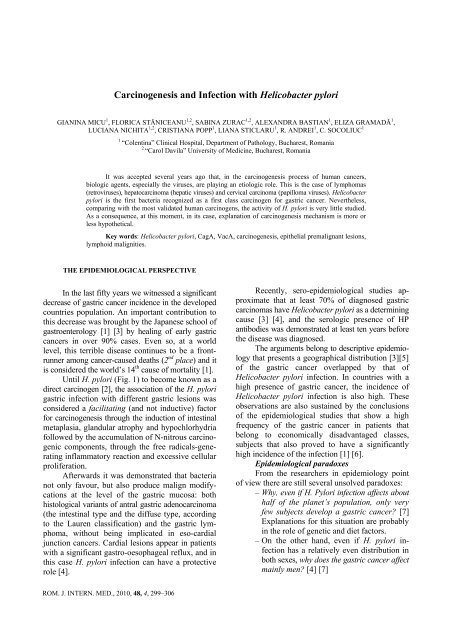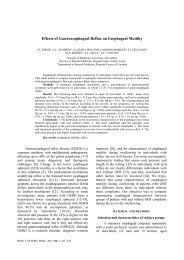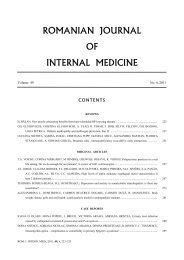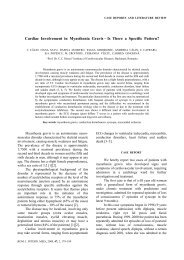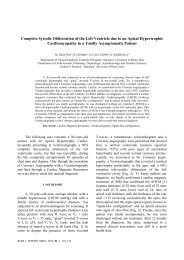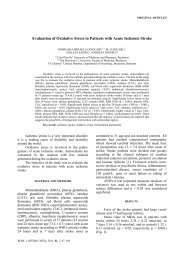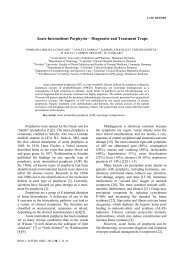Carcinogenesis and Infection with Helicobacter pylori
Carcinogenesis and Infection with Helicobacter pylori
Carcinogenesis and Infection with Helicobacter pylori
You also want an ePaper? Increase the reach of your titles
YUMPU automatically turns print PDFs into web optimized ePapers that Google loves.
<strong>Carcinogenesis</strong> <strong>and</strong> <strong>Infection</strong> <strong>with</strong> <strong>Helicobacter</strong> <strong>pylori</strong><br />
GIANINA MICU 1 , FLORICA STĂNICEANU 1,2 , SABINA ZURAC 1,2 , ALEXANDRA BASTIAN 1 , ELIZA GRAMADĂ 1 ,<br />
LUCIANA NICHITA 1,2 , CRISTIANA POPP 1 , LIANA STICLARU 1 , R. ANDREI 1 , C. SOCOLIUC 1<br />
1 “Colentina” Clinical Hospital, Department of Pathology, Bucharest, Romania<br />
2<br />
“Carol Davila” University of Medicine, Bucharest, Romania<br />
It was accepted several years ago that, in the carcinogenesis process of human cancers,<br />
biologic agents, especially the viruses, are playing an etiologic role. This is the case of lymphomas<br />
(retroviruses), hepatocarcinoma (hepatic viruses) <strong>and</strong> cervical carcinoma (papilloma viruses). <strong>Helicobacter</strong><br />
<strong>pylori</strong> is the first bacteria recognized as a first class carcinogen for gastric cancer. Nevertheless,<br />
comparing <strong>with</strong> the most validated human carcinogens, the activity of H. <strong>pylori</strong> is very little studied.<br />
As a consequence, at this moment, in its case, explanation of carcinogenesis mechanism is more or<br />
less hypothetical.<br />
Key words: <strong>Helicobacter</strong> <strong>pylori</strong>, CagA, VacA, carcinogenesis, epithelial premalignant lesions,<br />
lymphoid malignities.<br />
THE EPIDEMIOLOGICAL PERSPECTIVE<br />
In the last fifty years we witnessed a significant<br />
decrease of gastric cancer incidence in the developed<br />
countries population. An important contribution to<br />
this decrease was brought by the Japanese school of<br />
gastroenterology [1] [3] by healing of early gastric<br />
cancers in over 90% cases. Even so, at a world<br />
level, this terrible disease continues to be a frontrunner<br />
among cancer-caused deaths (2 nd place) <strong>and</strong> it<br />
is considered the world’s 14 th cause of mortality [1].<br />
Until H. <strong>pylori</strong> (Fig. 1) to become known as a<br />
direct carcinogen [2], the association of the H. <strong>pylori</strong><br />
gastric infection <strong>with</strong> different gastric lesions was<br />
considered a facilitating (<strong>and</strong> not inductive) factor<br />
for carcinogenesis through the induction of intestinal<br />
metaplasia, gl<strong>and</strong>ular atrophy <strong>and</strong> hypochlorhydria<br />
followed by the accumulation of N-nitrous carcinogenic<br />
components, through the free radicals-generating<br />
inflammatory reaction <strong>and</strong> excessive cellular<br />
proliferation.<br />
Afterwards it was demonstrated that bacteria<br />
not only favour, but also produce malign modifycations<br />
at the level of the gastric mucosa: both<br />
histological variants of antral gastric adenocarcinoma<br />
(the intestinal type <strong>and</strong> the diffuse type, according<br />
to the Lauren classification) <strong>and</strong> the gastric lymphoma,<br />
<strong>with</strong>out being implicated in eso-cardial<br />
junction cancers. Cardial lesions appear in patients<br />
<strong>with</strong> a significant gastro-oesophageal reflux, <strong>and</strong> in<br />
this case H. <strong>pylori</strong> infection can have a protective<br />
role [4].<br />
Recently, sero-epidemiological studies approximate<br />
that at least 70% of diagnosed gastric<br />
carcinomas have <strong>Helicobacter</strong> <strong>pylori</strong> as a determining<br />
cause [3] [4], <strong>and</strong> the serologic presence of HP<br />
antibodies was demonstrated at least ten years before<br />
the disease was diagnosed.<br />
The arguments belong to descriptive epidemiology<br />
that presents a geographical distribution [3][5]<br />
of the gastric cancer overlapped by that of<br />
<strong>Helicobacter</strong> <strong>pylori</strong> infection. In countries <strong>with</strong> a<br />
high presence of gastric cancer, the incidence of<br />
<strong>Helicobacter</strong> <strong>pylori</strong> infection is also high. These<br />
observations are also sustained by the conclusions<br />
of the epidemiological studies that show a high<br />
frequency of the gastric cancer in patients that<br />
belong to economically disadvantaged classes,<br />
subjects that also proved to have a significantly<br />
high incidence of the infection [1] [6].<br />
Epidemiological paradoxes<br />
From the researchers in epidemiology point<br />
of view there are still several unsolved paradoxes:<br />
– Why, even if H. Pylori infection affects about<br />
half of the planet’s population, only very<br />
few subjects develop a gastric cancer? [7]<br />
Explanations for this situation are probably<br />
in the role of genetic <strong>and</strong> diet factors.<br />
– On the other h<strong>and</strong>, even if H. <strong>pylori</strong> infection<br />
has a relatively even distribution in<br />
both sexes, why does the gastric cancer affect<br />
mainly men? [4] [7]<br />
ROM. J. INTERN. MED., 2010, 48, 4, 299–306
300<br />
Gianina Micu et al. 2<br />
– How come there are areas where the<br />
infection’s prevalence is very high (around<br />
100%), but the gastric cancer’s prevalence<br />
is almost null? [1] [5] [7].<br />
But, <strong>with</strong> or <strong>with</strong>out clarifying the epidemiological<br />
paradoxes that, one fact remains certain: the<br />
risk of developing gastric cancer by a person <strong>with</strong><br />
H. <strong>pylori</strong> infection is under 1% <strong>and</strong> seems to<br />
depend on the interaction between the virulence<br />
factors of the infecting bacteria strain <strong>and</strong> the host’s<br />
genetically-determined immune response [8].<br />
The implications of H. <strong>pylori</strong> in carcinogenesis<br />
are sustained by epidemiological studies as<br />
well as by animal models <strong>and</strong> researches made for<br />
clarifying the molecular mechanisms involved in<br />
gastric carcinogenesis. Most gastric cancers are<br />
preceded by premalignant lesions that evolve for<br />
decades. Atrophic gastritis perturbs the secretion of<br />
gastric acid by increasing the pH, allowing gastric<br />
colonization <strong>with</strong> anaerobe bacteria. These bacteria<br />
produce reductase, implicated in the formation of<br />
N-nitroso carcinogenic components [8] [9].<br />
PATHOGENIC MECHANISMS OF INDUCTION IN<br />
GASTRIC CARCINOGENESIS<br />
H. <strong>pylori</strong> induces carcinogenesis both directly<br />
through his virulence factors, as well as indirectly<br />
through the induction of the inflammatory response<br />
from the host [7–9].<br />
A. DIRECT FACTORS – VIRULENCE FACTORS OF<br />
HELICOBACTER PYLORI<br />
The direct carcinogenetic action of <strong>Helicobacter</strong><br />
<strong>pylori</strong>: <strong>Helicobacter</strong> <strong>pylori</strong>’s virulence factors<br />
are produced due to its endowment <strong>with</strong> a series of<br />
structural factors or the bacteria’s secretion products,<br />
among which the most significant are urease,<br />
phospholipase A, proteolytic enzymes, adhesins –<br />
common to all <strong>Helicobacter</strong> <strong>pylori</strong> strains–, as well<br />
as the cag cytotoxin, present in 60–70% of the<br />
strains <strong>and</strong> the vacuolisant protein vacA, present in<br />
60–65% of <strong>Helicobacter</strong> <strong>pylori</strong> strains [10] [11].<br />
<strong>Helicobacter</strong> <strong>pylori</strong> genome is heterogenic,<br />
<strong>with</strong> some strains playing a more significant role in<br />
developing malignity. This gene group bears the<br />
name of pathogen islet CagA (PAI) <strong>and</strong> is made of<br />
31 genes. While the positive CagA types are<br />
proved to imply a high risk of gastric cancer in the<br />
Western population, in Asian population this<br />
correlation is poorly supported. The vacuolisant<br />
cytotoxin vacA is responsible for the lesion of<br />
epithelial cells associated <strong>with</strong> carcinogenesis –<br />
genotypes vacA s1 <strong>and</strong> vacA m1 have a high<br />
malignnant potential. The carcinogenetic action of<br />
both CagA <strong>and</strong> vacA was expressed experimentally<br />
through their inoculation in Mongolian gorillas,<br />
which determined intestinal metaplasia <strong>and</strong> gastric<br />
cancer. On the other h<strong>and</strong>, the development of B cells<br />
gastric lymphoma was recently associated <strong>with</strong><br />
virulent forms of H. <strong>pylori</strong>, such as HopZ [11–13].<br />
Oxidative stress. Gastritis is associated <strong>with</strong><br />
the increase in production of nitric acid (NO). The<br />
nitroso components are recognized as gastric carcinogens<br />
in experimental milieus.<br />
Among the host’s response factors to <strong>Helicobacter</strong><br />
<strong>pylori</strong> infection, interleukin 1 <strong>and</strong> the necrotic<br />
tumoral factor (TNF–A–308) present a high risk<br />
for gastric cancer.<br />
B. INDIRECT FACTORS – CHRONIC INFECTION AND<br />
ITS CONSEQUENCES ON GASTRIC MUCOSA CELLS<br />
The inflammation of the gastric mucosa<br />
infected <strong>with</strong> H. <strong>pylori</strong> implicates cytokines, gamma<br />
interferon, TN-α, IL-1b, IL-6, IL-8, IL-12 <strong>and</strong> IL-17.<br />
The expression of cytokines is secondary to the<br />
activation of the transcriptional factor NF-kB,<br />
activation induced in epithelial cells through the<br />
translocation of the cagA gene. The intensity of the<br />
gastric inflammation depends on the host’s hereditary<br />
factors [12] [13]. Some H. <strong>pylori</strong> strains induce a<br />
severe inflammatory reaction while others are not<br />
at all accompanied by inflammation. This difference<br />
of the inflammation degree is parallel to the<br />
balance of pro- <strong>and</strong> anti-inflammatory cytokines.<br />
H. <strong>pylori</strong> is capable of modulating the cytokines’<br />
response. The bacteria’s genomic recombination<br />
seems to play a very important role in perpetuating<br />
the bacteria in spite of the inflammatory response.<br />
The bacteria can survive about 24 h the macrophages’<br />
phagosomes, the bacteria’s lipopolysaccharides<br />
inhibiting the macrophages’ apoptosis. On<br />
the other h<strong>and</strong>, the vacuolisant toxin vacA permits<br />
the survival in an acid milieu through the formation<br />
of intercellular vacuoles containing ammonia which<br />
is freed when the bacteria come into contact <strong>with</strong><br />
the cell’s apical pole. Thus, the bacteria’s virulence<br />
factors allow it to survive in spite of host’s immune<br />
response [14].<br />
I. CARCINOGENESIS ON THE EPITHELIAL LINE<br />
THE CARCINOGENIC CASCADE<br />
The carcinogenic cascade triggered by H. <strong>pylori</strong><br />
infection, as it was proposed by Correa et al in
3 <strong>Carcinogenesis</strong> <strong>and</strong> infection <strong>with</strong> H. <strong>pylori</strong> 301<br />
1975, goes through several important stages [1]<br />
[11] [17]:<br />
fundic <strong>and</strong> corporeal infection <strong>with</strong> <strong>Helicobacter</strong><br />
<strong>pylori</strong> → chronic gastritis → gl<strong>and</strong>ular atrophy →<br />
intestinal metaplasia → dysplasia → adenocarcinoma<br />
PREMALIGNANT LESIONS ON<br />
THE EPITHELIAL LINE<br />
The initial lesion is constituted by chronic<br />
gastritis together <strong>with</strong> the decrease of peptic acid<br />
secretion <strong>and</strong> of the intragastric ascorbic acid concentration,<br />
a substance recognised as having protective<br />
role against cancer (Fig. 2). The absence of H. <strong>pylori</strong><br />
in the areas of intestinal metaplasia, areas where<br />
the neoplastic transformation originates, suggests a<br />
distant carcinogenic influence through the bacteria’s<br />
products, as well as through the inflammatory<br />
response generated by the infection [9] [10] [19].<br />
Intestinal metaplasia associated to cancer is<br />
the incomplete type, either 2 or 3, <strong>and</strong> it is distributed<br />
diffusely, antro-fundic, or along the lesser curvature,<br />
from the cardia to the pylorus [18] – Fig. 3.<br />
As far as the atrophy associated <strong>with</strong> cancer<br />
is concerned, recent studies confirm that it can be<br />
continuous or multifocal, located most often antral<br />
<strong>and</strong> fundic. German researchers have put forward<br />
the hypothesis that the gastric cancer risk is higher<br />
in subjects <strong>with</strong> fundic-located gastritis if the level<br />
of activity is equal to the antral one. Japanese<br />
studies confirm the fact that the predominance of<br />
gastritis at the gastric fundus, as well as severe<br />
atrophy <strong>and</strong> intestinal metaplasia are risk factors<br />
for gastric cancer [17] [19]. Atrophy is defined by<br />
a gl<strong>and</strong>ular depletion, probably a consequence of a<br />
fault in the replacement of cells through apoptosis<br />
(Fig. 3). The histopathologic examination highlights<br />
the abundance of inflammatory cells <strong>and</strong> apoptotic<br />
epithelial cells at the level of the neck gl<strong>and</strong>s,<br />
which is precisely where there are epithelial strain<br />
cells. The multi factorial analysis done on patients<br />
<strong>with</strong> adenocarcinoma, duodenal ulcer or gastritis<br />
indicates the association between genotype s1 <strong>and</strong><br />
m1 cag <strong>and</strong> the density of the inflammatory infiltrate,<br />
the mucosa’s degree of atrophy <strong>and</strong> the type of<br />
intestinal metaplasia. A role in the appearance of<br />
the gastric mucosa atrophy seems to be also played<br />
by the auto-antibodies through the activation of the<br />
local immune system <strong>and</strong> the induction of a cellular<br />
mediated reaction followed by the destruction of<br />
parietal cells by cytotoxic lymphocytes [18–20].<br />
Apoptosis. Among the carcinogenesis<br />
mechanisms there is also the maladjustment of the<br />
apoptotic ways. Apoptosis is a form of geneticallyprogrammed<br />
cellular death in view of regulating<br />
the number of epithelial cells of the digestive tract.<br />
Both the presence of inflammatory mediators <strong>and</strong><br />
the secretion product of H. <strong>pylori</strong> can intervene<br />
directly in the enzyme cascade that forms the base<br />
of the molecular mechanisms of the apoptosis [19].<br />
As a consequence, modifications of the cellular turnover<br />
appear. The ways through which H. <strong>pylori</strong> can<br />
induce the acceleration of the apoptosis’ rhythm in<br />
the gastric epithelial cells belong to two main<br />
categories:<br />
a) Direct pathway, through the bacteria’s<br />
virulence factors, especially cagA, cagE<br />
<strong>and</strong> the vacuolisant cytotoxin vacA, which<br />
is confirmed by the absence of an accelerated<br />
apoptosis in infections <strong>with</strong> H. <strong>pylori</strong> strains<br />
<strong>with</strong> the above-mentioned virulence factors.<br />
b) Indirect pathway, via the inflammation’s<br />
mediators: the gamma interferon (IFN-γ)<br />
<strong>and</strong> TNF-α amplify the apoptosis induced<br />
by H. <strong>pylori</strong> through a mechanism that<br />
implies the over-expression of the Fas<br />
receptor at the level of gastric epithelial cells.<br />
This increases the susceptibility of gastric<br />
epithelial cells towards T-cells. Apoptosis is accelerated<br />
by a series of bacterial elements: ammonia,<br />
urease, ceramide [7] [18].<br />
In cell cultures the over expression of Bak<br />
(correspondent of the Bcl-2 protein, inductor of the<br />
apoptosis) was also noticed. At the present moment<br />
there are two theories regarding the significance of<br />
apoptosis in H. <strong>pylori</strong> infection. According to the<br />
first one, the induction of apoptosis stimulates the<br />
cellular proliferation, explaining the hyper prolixferative<br />
response of the host epithelium associated<br />
to the infection. The second theory affirms that, on<br />
the contrary, apoptosis could be the answer to<br />
epithelial hyper proliferation in view of preventing<br />
tissue hypertrophy [23].<br />
In vivo the apoptosis’ mechanisms depend<br />
significantly on the level of pro inflammatory<br />
cytokines (IL-8, IL-6, gamma interferon <strong>and</strong> TN-α).<br />
These induce apoptosis through the induction of<br />
synthetase nitrogen monoxide. NO has a degrading<br />
effect on the DNA, the increase in the production<br />
of NO can determine irreversible lesions of the<br />
genome <strong>and</strong> the appearance of pro carcinogenic<br />
mutations. The free radicals <strong>and</strong> NO induce the<br />
expression of the P53 protein, that repairs DNA’s<br />
lesions or produces cells’ apoptosis [20] [22].
302<br />
Gianina Micu et al. 4<br />
Epithelial proliferation – Fig. 4. In the<br />
gastric mucosa infected <strong>with</strong> H. <strong>pylori</strong> there is a<br />
concomitance between the accelerated apoptotic<br />
process <strong>and</strong> the cellular proliferation. When the<br />
balance between these two opposed effects processes<br />
is broken in favour of the proliferative factors, the<br />
evolution leads to cancer. Cellular proliferation is<br />
secondary to the inflammation induced by the<br />
H. <strong>pylori</strong> bacteria. The central role in its production<br />
seems to be played by cyclooxygenase Cox-2 <strong>and</strong><br />
nitrogen monoxide (NO), both expressed at an<br />
increased level in gastric adenocarcinoma. Excessive<br />
cellular proliferation decreases significantly after<br />
the eradication of H. <strong>pylori</strong> infection [20]. On the<br />
other h<strong>and</strong>, one must note its increase in the<br />
absence of a parallel increase of the apoptosis, of<br />
genetic (genetic mutations) or epigenetic (modifycations<br />
of the gene’s expression) alterations. Genetic<br />
modifications seem to be more precocious in the<br />
diffuse-type cancer than in the intestinal type, even<br />
if in the latter’s case precancerous lesions such as<br />
intestinal metaplasia can be described. Somatic<br />
mutations of gene E-cadherine or a hypermethylation<br />
of one of these gene’s promoters are<br />
characteristic to the diffuse type of adenocarcinoma,<br />
while for the intestinal type the mutations frequently<br />
affect gene p53. Mutations of the APC <strong>and</strong> betacatenina<br />
genes are much rarer. All these genetic<br />
modifications can be induced by the oxidative<br />
stress produced by H. <strong>pylori</strong> [20] [22] [24].<br />
H. <strong>pylori</strong> interferes in angiogenesis through<br />
the induction of a vascular factor for endothelial<br />
growth – A (VEGF – A). Other growth factors<br />
induced through H. <strong>pylori</strong>’s virulence include the<br />
epidermal growth factor (EGF), the heparin growth<br />
factor (EGF-like) <strong>and</strong> amphiregulin. Through the<br />
CagA protein it also activates the c-Met growth<br />
factor.<br />
There are numerous studies that describe<br />
cellular <strong>and</strong> genetic modifications in malignant<br />
gastric cells: the affection of the intercellular adhesion<br />
owing to the mutations E-cadherin, alpha <strong>and</strong> betacatenins,<br />
as well as to the increase in the activity of<br />
telomerase <strong>and</strong> the instability of microsatellites.<br />
The most common genetic abnormalities are<br />
connected to p53, as well as to the activation of the<br />
oncogenes c-Med <strong>and</strong> Her2/Neu, while the K-raz<br />
mutations occur less <strong>and</strong> less frequently. It was<br />
demonstrated that some of these genetic modifycations<br />
can appear even before intestinal metaplasia is<br />
installed [20] [25].<br />
Intraepithelial neoplasia (“dysplasia”) represents<br />
a renewal <strong>and</strong> tissue-development process;<br />
it is frequently associated to chronic gastritis <strong>and</strong><br />
can recede under treatment. It appears at the level<br />
of the normal gastric mucosa <strong>and</strong> is signalled by a<br />
foveolar hyper-proliferation <strong>and</strong>/or intestinal metaplasia.<br />
Cytoarchitectural alterations start at the level<br />
of the gl<strong>and</strong>s’ neck, where gl<strong>and</strong>s appear grouped<br />
in small “packages”. It can be plane/polypoid/<br />
depressed from a macroscopic point of view, <strong>with</strong> a<br />
microscopic tubular/tubulo-villous/ villous or<br />
papillary pattern [20–22] [25] – Fig. 5.<br />
Microscopic criteria of considering the gastric<br />
intraepithelial neoplasia are:<br />
– structural disorganisation: deformation of<br />
the crypts, the appearance of epithelial<br />
intraluminal buds, the relation between the<br />
epithelial tissue <strong>and</strong> the conjunctive one,<br />
modified in favour of the former.<br />
– the presence of cellular atypia, predominantly<br />
nuclear: polymorphism, hyperchromasia,<br />
loss of nuclear polarity, stratification, presence<br />
of an increased number of mitoses.<br />
– anomalies of differentiation: modification<br />
of the secretion, increase of the number of<br />
non-differentiated cells.<br />
According to these criteria two types of intraepithelial<br />
neoplasia can be described, comprising<br />
the three degrees of epithelial dysplasia formerly<br />
described: low degree intraepithelial neoplasia<br />
(light <strong>and</strong> medium epithelial dysplasia) <strong>and</strong> high<br />
degree intraepithelial neoplasia (severe epithelial<br />
dysplasia); the cases which lack of criteria for a<br />
certain definition are classified in the indefinite<br />
intraepithelial neoplasia category (OMS) [1] [25].<br />
In the low degree intraepithelial neoplasia,<br />
the mucosa’s architecture is slightly modified, <strong>and</strong><br />
it presents tubular ramified/ budded structures, <strong>with</strong><br />
elongated crypts, cystic dilatations, gl<strong>and</strong>s covered<br />
by large-size, low-Muncie columnar cells; pseudo<br />
stratified vesiculous round-ovoid nuclei.<br />
In the case of high degree intraepithelial<br />
neoplasia visible architectural distortions appear;<br />
the tubes gain an irregular, ramified shape; the<br />
gl<strong>and</strong>ules become crowded <strong>and</strong> one can identify<br />
visible cellular atypical situations; there is no<br />
stromal invasion; the mucus secretion is either<br />
minimal or absent; the nuclei become pseudo<br />
stratified, pleomorphic, hyperchromatic, cigar-shaped<br />
<strong>with</strong> prominent, amphophilous nucleoli.<br />
THE PROGRESSION OF INTRAEPITHELIAL<br />
NEOPLASIA TOWARDS CARCINOMA<br />
Over 80% of intraepithelial neoplasia cases<br />
progress towards invasion. The carcinoma diagnosis<br />
is imposed when the tumour invades lamina<br />
propria (intramucous carcinoma) or the muscularis<br />
mucosae [24] [27].
5 <strong>Carcinogenesis</strong> <strong>and</strong> infection <strong>with</strong> H. <strong>pylori</strong> 303<br />
N.B.: the association of extensive lesions of<br />
intestinal metaplasia <strong>with</strong> lesions of intraepithelial<br />
neoplasia in the presence of the sulphomucinesecreting<br />
phenotype has a high risk of evolving<br />
towards carcinoma – Figs. 6, 7.<br />
PHYSIOPATHOLOGICAL AND CLINIC<br />
MODIFICATIONS: GASTRITIS,<br />
HYPOCHLORHYDRIA AND THE RISK OF<br />
ADENOCARCINOMA<br />
The chronic infection <strong>with</strong> H. <strong>pylori</strong> can lead<br />
in time to the appearance of pan gastritis when<br />
inflammatory lesions at the level of the fundic<br />
mucosa lead to the decrease of the acid secretion.<br />
From a physiopathological point of view, hypochlorhydria<br />
is partly caused by the decrease in the<br />
secretion of histamines by the ECL cells; on the<br />
other h<strong>and</strong>, the parietal cells’ acid secretion is<br />
inhibited by TN-α <strong>and</strong> IL1β [26].<br />
H. <strong>pylori</strong> infection induces an immune reaction<br />
from the organism, whose first stage is the alteration<br />
of gastric epithelium through the presence of the<br />
bacteria in the mucosa that covers cells’ apical pole.<br />
The consequence is secretion of numerous chemotactic<br />
factors, of cytokines <strong>and</strong> the stimulation of<br />
lymphocytes. Even if sometimes it is spontaneously<br />
eliminated by local defence mechanisms, in most<br />
cases the infection continues to persist. In time, it<br />
appears a local inflammatory reaction that provokes<br />
the acceleration of the cellular turn-over <strong>and</strong>,<br />
sometimes, genomic lesions that can lead to cancer<br />
if lesions of the DNA-repair mechanisms appear.<br />
Chronic inflammation can also induce hypochlorhydria<br />
in patients <strong>with</strong> a pre inflammatory genotype<br />
of interleukins. Convergence of bacterial virulence<br />
factors <strong>with</strong> the host’s immune response can generate<br />
varied diseases, from ulcer to the atrophy of the<br />
mucosa <strong>and</strong> afterwards the development of cancer<br />
[26] [27].<br />
applied by Wong <strong>and</strong> his team) suggest the fact<br />
that the eradication of H. <strong>pylori</strong> reduces the<br />
incidence of gastric cancer only in patients that did<br />
not present gastric atrophy <strong>and</strong>/or intestinal metaplasia.<br />
But even in the case where these lesions’<br />
point of no return has been surpassed, eradication<br />
of H. <strong>pylori</strong> seems to stop their evolution. The<br />
regression of precancerous lesions is thought 66%<br />
possible for patients that become H. <strong>pylori</strong> negative<br />
after treatment <strong>and</strong> only 14% possible for patients<br />
that stay positive after treatment [1] [26].<br />
According to some studies, non-atrophic<br />
gastritis is completely reversible after the eradication<br />
of the H. <strong>pylori</strong> infection. Others, in contrast<br />
[19] [28], have demonstrated that both atrophic<br />
gastritis <strong>and</strong> intestinal metaplasia could be reversible,<br />
even if these studies have noticed a decrease in the<br />
incidence of gastric cancer; this was though related<br />
to the decrease of cellular proliferation after<br />
eradication of active infection [27].<br />
Some researchers [20] [26] mentioned the<br />
existence of a stage of pre-atrophic gastritis in<br />
which the parietal epithelial cells have disappeared,<br />
but the gl<strong>and</strong>ular architecture was conserved <strong>and</strong><br />
the strain cells were also not affected. At least<br />
theoretically, at this stage the lesions are reversible.<br />
To conclude, the real amplitude of the role<br />
played by H. <strong>pylori</strong>’s eradication in the prevention<br />
of gastric cancer remains still a subject for study.<br />
As long as after the eradication of H. <strong>pylori</strong><br />
precancerous lesions stop evolving <strong>and</strong>, sometimes,<br />
they even regress, the practical decision imposes<br />
itself: the infection’s treatment must be applied<br />
even <strong>with</strong>out the evidence of pre neoplasia modifications.<br />
Another important, but theoretical idea, is<br />
that of the existence of the point of no-return, beyond<br />
which bacteria-induced genetic modifications make<br />
atrophy <strong>and</strong> intestinal metaplasia irreversible, in<br />
spite of the elimination of the carcinogen agent<br />
(H. <strong>pylori</strong>) [25–27].<br />
ERADICATION OF H. PYLORI AND PREVENTION<br />
OF GASTRIC CANCER<br />
The major problem <strong>with</strong> gastric cancer prevention<br />
strategies derives at this moment from the<br />
fact that we do not know exactly at which stage<br />
gastritis, atrophy, intestinal metaplasia or intraepithelial<br />
neoplasia become irreversible. R<strong>and</strong>om,<br />
prospective studies <strong>and</strong> placebo (like the one<br />
REVERSIBILITY OF PRECANCEROUS LESIONS<br />
At the present moment there are still few<br />
studies concerning the role that the infection’s<br />
eradication can have in the prevention of the gastric<br />
cancer through the reversibility of pre neoplasia<br />
modifications: atrophic gastritis, intestinal metaplasia<br />
<strong>and</strong> the intraepithelial neoplasia of different<br />
degrees [16] [25] [26].
304<br />
Gianina Micu et al. 6<br />
II. PATHOGENESIS OF H. PYLORI-INDUCED<br />
LYMPHOID MALIGNITIES<br />
As far as the malign transformation on a<br />
lymphoid line is concerned, the pathogenic sequence<br />
described above at this moment is the following:<br />
Gastric infection <strong>with</strong> <strong>Helicobacter</strong> <strong>pylori</strong>→<br />
lymphoid hyperplasia → clone abnormalities at<br />
the level of B lymphoid population → low degree<br />
MALT lymphoma dependent on the <strong>Helicobacter</strong><br />
<strong>pylori</strong> infection’s level→ (possibly via the<br />
t translocation (1;14) → low degree MALT lymphoma<br />
independent of the level of <strong>Helicobacter</strong><br />
<strong>pylori</strong> infection→ (possibly via the p53 mutation)<br />
→ high degree MALT lymphoma.<br />
EPIDEMIOLOGY<br />
Epidemiological studies, as well as the<br />
detection of the H. <strong>pylori</strong> infection in most gastric<br />
lymphomas have proved the tight connection<br />
between these <strong>and</strong> the bacteria. The regression <strong>and</strong><br />
even healing of some lymphomas following the<br />
antibiotic treatment aimed at H. <strong>pylori</strong> infection<br />
also come in support of this idea [1] [21].<br />
The carcinogenetic steps in this case begin<br />
<strong>with</strong> the activation of T cells in the presence of the<br />
chronic H. <strong>pylori</strong> infection, starting towards cells<br />
that further on activate the population of polyclonal<br />
B lymphocytes. In time, a proliferation of monoclonal<br />
B cells <strong>with</strong> the possible accumulation of<br />
genetic mutations takes place. Because the lymphoma<br />
appears in the lymphoid tissue associated to the<br />
mucosa (MALT), they are called MALT-oms. B-cells<br />
that proliferate come from the lymphoid follicle’s<br />
peripheral area, which explains this tumour’s other<br />
name, that of marginal area lymphoma [1] [21] [24].<br />
Even if the first studies concerning the low<br />
degree MALT lymphoma launched the idea of the<br />
presence of <strong>Helicobacter</strong> <strong>pylori</strong> infection among<br />
the etiologic factors up to 98%, more recent studies<br />
keep the bacteria in the fore-group, but decrease its<br />
incidence at 62–77%. It was proven that lymphoma<br />
is preceded by a H. <strong>pylori</strong> infection, but there are<br />
still controversies concerning this theme, especially<br />
because a series of serious studies have published<br />
partially contradicting results. For example, some<br />
studies mention the association between high degree<br />
lesions <strong>and</strong> positive cagA strains <strong>and</strong> the nonassociation<br />
of this strain <strong>with</strong> low degree lymphoma<br />
[21].<br />
THE MALT LYMPHOMA CONCEPT<br />
The term MALT was proposed by Isaacson et<br />
al. for the immune system’s components developed<br />
at the level of the gastrointestinal tract’s mucosa;<br />
these contain lymph ganglions (which in ileum form<br />
the Payer paches), the lymphocyte <strong>and</strong> plasmocytes<br />
in lamina propria <strong>and</strong> the intraepithelial lymphocytes.<br />
These immune components of the MALT<br />
system have distinct morph functional traits, as well<br />
as the lymphoma developed from them (MALT). It is<br />
considered that, in order to develop a tumour from<br />
this tissue, an important role is played by H. <strong>pylori</strong>,<br />
the latter’s eradication leading to the lymphoma’s<br />
remission [1] [28].<br />
Between the lymphoid follicles there are<br />
variable sized lymphoid cells, <strong>with</strong>out mitosis,<br />
frequent immunoblasts, post-capillary venules <strong>and</strong><br />
sometimes plasmocytes – Fig. 8.<br />
The specific immunohistochemical markers<br />
are: CD19, CD20, CD21, CD35, bcl-2, sometimes<br />
CD43.<br />
LYMPHOID HYPERPLASIA<br />
Lymphoid hyperplasia, named until recently<br />
“pseudo-lymphoma”, represents a reactive condition<br />
that appears frequently in association <strong>with</strong> ulcerations/<br />
gastric erosions <strong>and</strong> who is accompanied by an<br />
extensive fibrosis <strong>and</strong> a vascular proliferation. At a<br />
microscopic level, one can describe the presence of<br />
reactive germinal centres in a polymorph inflammatory<br />
population (including mature lymphocytes <strong>and</strong><br />
plasmocytes).<br />
Initially, the pseudo-lymphoma was considered<br />
a benign reactive inflammatory process. Later on, it<br />
was recognised as a pre-malignant lesion. At the<br />
present moment, thanks to data provided by immunohistochemical<br />
studies <strong>and</strong> molecular biology, that<br />
can make the difference between monoclonal (neoplasia)<br />
<strong>and</strong> polyclonal (reactive) lymph proliferations,<br />
the term of pseudo-lymphoma is not longer used<br />
[1] [23].<br />
MAIN CHARACTERISTICS OF MALT<br />
GASTRIC LYMPHOMA<br />
Over 95% of gastric lymphoma is non-Hodgkin<br />
type. Most of them are B cells lymphoma, T cells<br />
being reported fewer than 8%.
7 <strong>Carcinogenesis</strong> <strong>and</strong> infection <strong>with</strong> H. <strong>pylori</strong> 305<br />
Lesions appear at the level of the mucosa’s<br />
junction <strong>with</strong> the submucosa, making difficult at<br />
this stage a diagnosis through endoscopic biopsy.<br />
Also difficult is the differentiation of the low-degree<br />
malignity lymphoma from benign inflammatory<br />
infiltrates at the level of endoscopic biopsies. In<br />
early or borderline cases there can be significant<br />
confusions <strong>with</strong> follicular gastritis. In these cases it<br />
is necessary to have a immunohistochemical <strong>and</strong><br />
molecular confirmation of the monoclonality of<br />
B cells [1] [21] [23].<br />
THE TUMORIGENIC ROLE OF H. PYLORI<br />
IN MALT-TYPE GASTRIC LYMPHOMA<br />
It was demonstrated (Isaacson et al. 1984,<br />
Wyatt et al. 1988, Worth Erspool, 1991) that chronic<br />
H. <strong>pylori</strong> infection determines the stimulation of<br />
the lymphoid tissue in the gastric mucosa. The<br />
presence of lymphoid follicles at this level is<br />
pathognomonic to the long-term infection <strong>with</strong> H.<br />
<strong>pylori</strong>; the appearances of lymphoepithelial lesions<br />
definitely mark the development of a MALT<br />
lymphoma. The chronic infection <strong>with</strong> <strong>Helicobacter</strong><br />
<strong>pylori</strong> determines the recruitment of B <strong>and</strong> T cells<br />
in gastric mucosa as an immune response. The<br />
proliferation of B cells is secondary to the specific<br />
activation of T cells by the bacteria <strong>and</strong> cytokines.<br />
Because gene alterations of the malign clone are<br />
not sufficient for insuring autonomy in relation to<br />
cellular death, the MALT lymphoma can regress<br />
the anti-<strong>Helicobacter</strong> <strong>pylori</strong> treatment. In time, the<br />
malignant clone can accumulate varied gene<br />
alterations (t (1; 14)), inactivation of the p53 gene<br />
or the p16 gene) that determine acquiring of an<br />
autonomous proliferation capacity <strong>and</strong>/or apoptosis<br />
inhibition. As a consequence, the low degree MALT<br />
lymphoma that would have responded to the<br />
antibiotic treatment become high degree lymphoma<br />
that do not respond to the antibiotic treatment<br />
anymore <strong>and</strong> tend to lead to metastasis.<br />
TUMOUR CELLS E RESPONSE OF<br />
TO H. PYLORI INFECTION<br />
Tumour B cells are not directly stimulated by<br />
the bacteria. H. <strong>pylori</strong> stimulate the intratumoral<br />
T cells that, in their turn, favour the proliferation of<br />
tumour cells. It was demonstrated that the same<br />
patient’s spleen T cells do not respond to H. <strong>pylori</strong>,<br />
which implies that the population of T cells<br />
responsive to the bacteria is a local one. This is one<br />
of the explanations for the fact that the MALT<br />
gastric lymphoma at least initially remains localized,<br />
the lymphoma being dependent on the activated<br />
T cells present in great number in H. <strong>pylori</strong> produced<br />
gastritis [24].<br />
It is necessary for the progenitors of the<br />
malign B cells clone to have certain properties, a<br />
possible genetic alteration or the ability to recognise<br />
antigens that allow their uncontrolled proliferation<br />
in the presence of T cells. The MALT lymphomatous<br />
cells present a genetic instability, genetic<br />
anomalies <strong>and</strong> respond to a variety of auto antigens.<br />
In 2000, De Jong proposed a model of oncogenesis<br />
for the MALT-type gastric lymphoma.<br />
H. <strong>pylori</strong> → chronic gastritis → gastric lymphoma<br />
Non H type MALT, low malignity → gastric<br />
lymphoma Non H type MALT, high malignity. If<br />
the passage from chronic gastritis to the low degree<br />
MALT lymphoma is regulated through immunological<br />
processes, the passage to the high degree<br />
lymphoma is achieved through an autonomous<br />
proliferation [23] [26].<br />
REGRESSION OF THE MALT GASTRIC LYMPHOMA<br />
AFTER ERADICATION OF H. PYLORI<br />
Antibiotic therapy for the MALT gastric<br />
lymphoma is efficient only in low degree lymphoma<br />
<strong>and</strong> the extension is limited to the mucosa <strong>and</strong>/or<br />
the submucosa [23] [25] [28].<br />
__________________________________________________________________<br />
În procesul carcinogenezei cancerelor umane au fost acceptaţi de mulţi ani<br />
agenţi biologici cu rol etiologic, în special virusurile. Acesta este cazul limfoamelor<br />
(retrovirusurile), hepatocarcinomului (virusurile hepatitice) şi cancerului de col<br />
uterin (papiloma virusurile). <strong>Helicobacter</strong> <strong>pylori</strong> este prima bacterie recunoscută<br />
ca şi carcinogen de clasa I, fiind demonstrat epidemiologic ca agent cauzal pentru<br />
cancerul gastric. Totuşi, prin comparaţie cu cei mai mulţi carcinogeni umani<br />
validaţi, acţiunea carcinogenetică a H. <strong>pylori</strong> este încă puţin experimentată. În<br />
consecinţă, la momentul prezent, în cazul său, explicarea mecanismelor carcinogenezei<br />
este încă mai mult sau mai puţin una ipotetică.<br />
__________________________________________________________________
306<br />
Gianina Micu et al. 8<br />
Correponding author: Gianina Micu<br />
Colentina Clinical Hospital, Department of Pathology<br />
19–21 Şos. Ştefan cel Mare, Bucharest<br />
E-mail: dr_geanina@yahoo.com<br />
REFERENCES<br />
1. World Health Organisation Classification of Tumours, Pathology <strong>and</strong> Genetics of Tumours of Digestive System, IARC press,<br />
Lyon, 2003.<br />
2. PARSONNET J., FRIEDMAN G.D., VANDERSTEEN D.P. et al., <strong>Helicobacter</strong> <strong>pylori</strong> infection <strong>and</strong> the risk of gastric<br />
carcinoma. N Engl J Med., 325:1127–1131, 1991.<br />
3. MINOHARA Y., BOYD D.K., HAWKINS H.K., ERNST P.B., PATEL J., CROWE S.E., The Effect of the cag Pathogenicity<br />
Isl<strong>and</strong> on Binding of <strong>Helicobacter</strong> <strong>pylori</strong> to Gastric Epithelial Cells <strong>and</strong> the Subsequent Induction of Apoptosis. <strong>Helicobacter</strong>,<br />
2007; 12:583–90.<br />
4. MOSS S.F., MALFERTHEINER P., <strong>Helicobacter</strong> <strong>and</strong> gastric malignancies. <strong>Helicobacter</strong>, 2007, 12 Suppl. 1:23–30. Review.<br />
5. DING S.Z., GOLDBERG J.B., HATAKEYAMA M., <strong>Helicobacter</strong> <strong>pylori</strong> infection, oncogenic pathways <strong>and</strong> epigenetic<br />
mechanisms in gastric carcinogenesis. Future Oncol., 2010; 6:851–62.<br />
6. LADABAUM U., DINH V., Rate <strong>and</strong> yield of repeat upper endoscopy in patients <strong>with</strong> dyspepsia. World J Gastroenterol., 2010;<br />
16:2520–2525.<br />
7. POLK D.B., PEEK R.M. Jr., <strong>Helicobacter</strong> <strong>pylori</strong>: gastric cancer <strong>and</strong> beyond. Nat Rev Cancer, 2010; 10:403–14.<br />
8. BARROS R., CAMILO V., PEREIRA B., FREUND J.N,. DAVID L., ALMEIDA R., Pathophysiology of intestinal metaplasia<br />
of the stomach: emphasis on CDX2 regulation. Biochem Soc Trans., 2010; 38:358–63.<br />
9. HONG S., LEE H.J., KIM S.J., Hahm K.B., Connection between inflammation <strong>and</strong> carcinogenesis in gastrointestinal tract:<br />
Focus on TGF-β signaling. World J Gastroenterol., 2010; 16:2080–2093.<br />
10. LAGNER M., MACHADO R.S., PATRICIO F.R., KAWAKAMI E., Evaluation of gastric histology in children <strong>and</strong><br />
adolescents <strong>with</strong> <strong>Helicobacter</strong> <strong>pylori</strong> gastritis using the Update Sydney System. Arq Gastroenterol., 2009; 46:328–32.<br />
11. Correa P., The gastric precancerous process. Cancer Surv, 2:437–450, 1983.<br />
12. LIU D., HE Q., LIU C., Correlations among <strong>Helicobacter</strong> <strong>pylori</strong> infection <strong>and</strong> the expression of cyclooxygenase-2 <strong>and</strong> vascular<br />
endothelial growth factor in gastric mucosa <strong>with</strong> intestinal metaplasia or dysplasia. J Gastroenterol Hepatol., 2010; 25:795–9.<br />
13. TANIH N.F., MCcMILLAN M., NAIDOO N., NDIP L.M., WEAVER L.T., NDIP R.N., Prevalence of <strong>Helicobacter</strong><br />
<strong>pylori</strong>vacA,cagA <strong>and</strong> iceA genotypes in South African patients <strong>with</strong> upper gastrointestinal diseases. Acta Trop., 2010 Jun 4<br />
[Epub ahead of print].<br />
14. MIENDJE DEYI V.Y., VANDERPAS J., BONTEMS P. et al., Marching cohort of <strong>Helicobacter</strong> <strong>pylori</strong> infection over two<br />
decades (1988–2007): combined effects of secular trend <strong>and</strong> population migration. Epidemiol Infect., 2010 Jun 7:1–9 [Epub<br />
ahead of print].<br />
15. SENTHILKUMAR C., NIRANJALI S., JAYANTHI V., RAMESH T., DEVARAJ H., Molecular <strong>and</strong> histological evaluation of<br />
tumor necrosis factor-alpha expression in <strong>Helicobacter</strong> <strong>pylori</strong>-mediated gastric carcinogenesis. J Cancer Res Clin Oncol., 2010<br />
May 29 [Epub ahead of print].<br />
16. ADAMU M.A., WECK M.N., ROTHENBACHER D., BRENNER H., Incidence <strong>and</strong> risk factors for the development of chronic<br />
atrophic gastritis: Five year follow-up of a population based cohort study. Int J Cancer, 2010 May 25 [Epub ahead of print].<br />
17. PARSONNET J., HANSEN S., RODRIQUEZ B.S., et al., <strong>Helicobacter</strong> <strong>pylori</strong> infection <strong>and</strong> gastric lymphoma. N Engl J Med.,<br />
330:1267–1271, 1994.<br />
18. COMPARE D., ROCCO A., NARDONE G., Risk factors in gastric cancer. Eur Rev Med Pharmacol Sci., 2010; 14:302–8.<br />
19. GIULIANI A., SPADA .S, CORONA M. et al., Cancer precursor lesions in intact stomach <strong>Helicobacter</strong> <strong>pylori</strong> gastritis <strong>and</strong> in<br />
resected stomach gastritis. J Exp Clin Cancer Res., 2003; 22:371–8.<br />
20. KIM Y.J., CHUNG J.W., LEE S.J., CHOI K.S., KIM J.H., HAHM K.B., Progression from chronic atrophic gastritis to gastric<br />
cancer; tangle, toggle, tackle <strong>with</strong> Korea red ginseng. J Clin Biochem Nutr., 2010; 46:195–204.<br />
21. ANDERSON L.A., MURPHY S.J., JOHNSTON B.T. et al., Relationship between <strong>Helicobacter</strong> <strong>pylori</strong> infection <strong>and</strong> gastric<br />
atrophy <strong>and</strong> the stages of the oesophageal inflammation, metaplasia, adenocarcinoma sequence: results from the FINBAR casecontrol<br />
study. Gut., 2007.<br />
22. SAGAERT X., VAN CUTSEM E., DE HERTOGH G., GEBOES K., TOUSSEYN T., Gastric MALT lymphoma: a model of<br />
chronic inflammation-induced tumor development. Nat Rev Gastroenterol Hepatol., 2010; 7:336–46.<br />
23. MAEDA S,, MENTIS A.F., Pathogenesis of <strong>Helicobacter</strong> <strong>pylori</strong> infection.<strong>Helicobacter</strong>. 2007 Oct; 12 Suppl 1:10–4. Review.<br />
24. TEPES B., Can gastric cancer be prevented? J Physiol Pharmacol., 2009; 60 Suppl 7:71–7.<br />
25. ROKKAS T., SECHOPOULOS P., PISTIOLAS D., MARGANTINIS G., KOUKOULIS G., <strong>Helicobacter</strong> <strong>pylori</strong> infection <strong>and</strong><br />
gastric histology in first-degree relatives of gastric cancer patients: a meta-analysis. Eur J Gastroenterol Hepatol., 2010 Apr 20<br />
[Epub ahead of print].<br />
26. DING S.Z., FISCHER W., KAPARAKIS-LIASKOS M. et al., <strong>Helicobacter</strong> <strong>pylori</strong>-induced histone modification, associated<br />
gene expression in gastric epithelial cells, <strong>and</strong> its implication in pathogenesis. PLoS One., 2010; 5:e9875.<br />
27. SHIN C.M., KIM N., JUNG Y. et al., Role of <strong>Helicobacter</strong> <strong>pylori</strong> infection in aberrant DNA methylation along multistep gastric<br />
carcinogenesis. Cancer Sci., 2010 Feb 18 [Epub ahead of print].<br />
28. KOSUNEN T.U., PUKKALA E., SAMA S. et al., Gastric cancers in finnish patients after cure of <strong>Helicobacter</strong> <strong>pylori</strong> infection:<br />
a cohort study. Int J Cancer., 2010 Mar 22 [Epub ahead of print].<br />
Received July 24, 2010
Fig. 1. – Numerous H. <strong>pylori</strong> organisms in the mucus at the<br />
apical pole of the surface epithelium, Giemsa stain, ob. 40×.<br />
Fig. 2. – Antral gastric mucosa showing chronic gastritis <strong>with</strong><br />
high grade of activity, presenting marked polymorph<br />
inflammatory infiltrate including lymphocytes <strong>and</strong> numerous<br />
neutrophils in lamina propria <strong>and</strong> intraepithelial, focally<br />
destroying the gl<strong>and</strong>ular epithelium; regenerative changes<br />
in the epithelium; HE stain, ob.20×.<br />
Fig. 3. – Inactive chronic gastritis <strong>with</strong> moderate gl<strong>and</strong>ular atrophy<br />
<strong>and</strong> limited areas of intestinal metaplasia; HE stain, ob.20×.<br />
Fig. 4. – Marked pseudopolypoid hyperplasia of the surface<br />
epithelium; HE stain, ob.10×.
Fig. 5. – Epithelial dysplasia – low <strong>and</strong> moderate grade (low<br />
grade intraepithelial neoplasia) <strong>with</strong> loss of the nuclear polarity<br />
<strong>and</strong> hyperchromatic nuclei, areas <strong>with</strong> pseudostratification of<br />
the gl<strong>and</strong>ular epithelium; Giemsa stain, ob.20×.<br />
Fig. 6. – Gastric adenocarcinoma – intestinal type (Lauren),<br />
tubulo-papilar; Giemsa, stain, ob.10×, respective ly signet ring<br />
carcinoma diffuse Lauren type.<br />
Fig. 7. – Gastric adenocarcinoma – intestinal type (Lauren),<br />
tubulo-papilar; Giemsa, stain, ob.10×, respective ly signet ring<br />
carcinoma diffuse Lauren type.<br />
Fig. 8. – Antral non-Hodgkin MALT type lymphoma; HE<br />
stain, 0b.10×.


